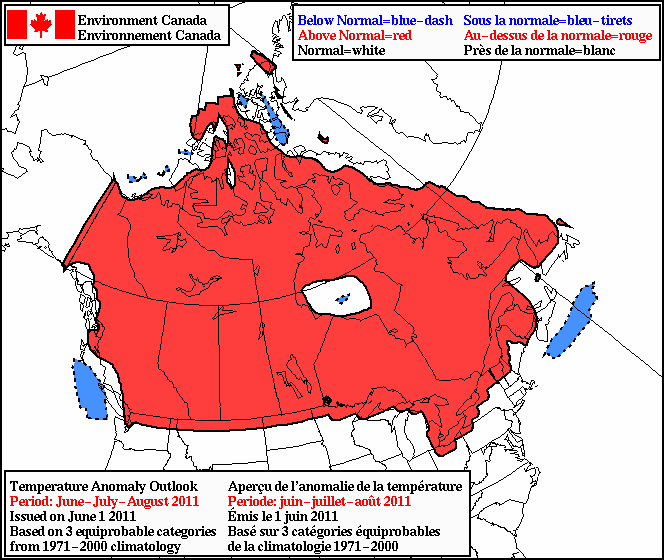What’s trending in corn production
REVIEWING 2011 AND MAKING PLANS FOR 2012
the 2011 corn growing season had a bit of everything: good, bad and ugly.
Are there lessons learned that we take with us into the 2012 growing season?
weather and corn planting decisions
Conditions early in the 2011 season were not conducive to planting, as April was relatively cool and May was significantly wetter than normal. Corn planting dragged into mid-June in some parts of the province. In early June many producers were asking whether to plant soybeans or corn. In the end the decision to plant corn and to stay with relatively full season hybrids worked out well in most areas. For example, the OCC trial at West Lorne was planted on June 13 and finished up with an average yield of 203 bushels per acre with average harvest moisture of 31 percent.
WEATHER MAP FROM ENVIRONMENT CANADA PREDICTING ABOVE AVERAGE TEMPERATURES FOR SUMMER 2011

What factors went into the decision to plant corn in June? We often discussed keeping crop rotations in balance, the price of corn being relatively high, the ability for today’s hybrids to withstand stresses and an Environment Canada forecast predicting above average temperatures for summer 2011. Now many of us are skeptical about any weather forecast, but over the past year or so the 90 day temperature forecast became more reliable.
Are we to a point that a 90 day forecast might contribute to real decision making like hybrid selection or how far to push planting into June? I think it is a tool that at least must be pulled out and looked at in the decision making process. Check out the Environment Canada website that allows you to look at and evaluate forecasts. http://www.weatheroffice.gc.ca/ saisons/index_e.html#forecasts
uniformity in the corn field
The somewhat backwards weather left many growers planting into seedbed conditions that were often less than perfect. As a result, there was concern over stands that were less uniform than desired. Added to that was a significant amount of promotion of planter modifications and discussions about planter performance. The result is that over this winter what to add or not add to your planter or what planter to buy or not buy has become one of the hot topics. Public research comparing actual planter modifications is scarce.
The one key message that has evolved from research work in Ontario is that uniformity in the corn stand that leads to high yields is certainly not defined by perfect spacing. In fact, uniform spacing has had a relatively small impact on yield. Uniformity means much more than spacing – it really requires residue management, tillage, fertility, wheel traffic and seeding depth control that combine to produce stands that emerge evenly and grow uniformly especially in that first four to six weeks after planting.
I am quite sure that at least some of the fairly sophisticated improvements to corn planters will eventually prove themselves. My concern is that these should not necessarily come before replacing the double disc openers that are worn out or purchasing a quality set of harrows for the back of the cultivator.
nitrogen management
Early season (April to June) weather conditions tended to reduce mineralization of organic matter or result in losses of nitrogen fertilizer through denitrification. The OMAFRA Pre-Sidedress Nitrate Test (PSNT) Survey done June 10 to 15 indicated soil nitrate levels that were below average. Research plots and producer fields tended to indicate above average nitrogen fertilizer requirements in 2011, most likely a combination of three factors:
• Reduced residual nitrogen from soil sources
• Losses of applied nitrogen
• Increased demand from high yield corn crops
2011 emerged as a year where general recommendations for nitrogen rates on corn (see www.gocorn.net Ontario Corn Nitrogen Calculator) were probably improved by taking soil nitrate tests in early June. These tests gave us an indication that weather conditions may have resulted in a need for additional nitrogen in some areas.
To head into 2012 with the opinion to simply apply more N everywhere is both economically and environmentally shortsighted. Our best strategy is to still follow general N recommendations and evaluate if April/May conditions warrant any adjustment.
western bean cutworm
It’s not going away. Western Bean Cutworm (WBC) continued to expand its range across Ontario in 2011. Average moth captures per trap nearly tripled compared with 2010 trap captures. The threshold was reached and control was required in isolated areas in Chatham-Kent, Lambton, Middlesex, Norfolk and Elgin. In areas where eggs and larvae were present and feeding damage was observed, estimated yield losses approached 7 bushels per acre or 3.4 percent yield loss.
We need to continue to stay on top of this emerging pest; this will mean careful hybrid selection, continued monitoring and pesticide applications in some cases. •







